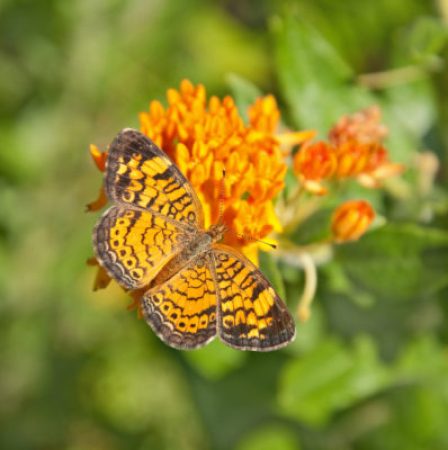
There’s something about the color orange that really appeals to the senses. Not nearly as aggressive as red, it nonetheless calls attention to itself in a cool, refreshing sort of way. So I was happy to hear that recently, an orange-flowering species received a perennial plant’s highest honor. In late November 2016, butterfly weed (Asclepias tuberosa) was named 2017 Perennial Plant of the Year.
ABOUT PERENNIAL OF THE YEAR

Each winter, the Perennial Plant Association awards Perennial Plant of the Year to the plant that outshines its competitors not only in appearance, but also in its noteworthy characteristics. In order to be considered, the perennial must be able to grow in a wide range of climates, require little maintenance, have multiple seasons of interest and be relatively pest and disease free.
That can be a tall order for a medium-sized plant like butterfly weed. But, its unique qualities enabled it to more than rise to the occasion.
A MILKWEED RELATIVE
Butterfly weed is native to the continental United States and parts of Canada, where it grows wild in dry forests, open fields, prairies and roadsides. Its preference for average to dry soil makes it naturally drought-tolerant.

Butterfly weed in a northern Illinois prairie/Photo: Jason Patrick Ross
A member of the milkweed family, the medium-sized plant usually grows to about 2 feet.

A key feature is its brilliant orange-yellow flowers that shine like a beacon. Blooming profusely from June through August, they produce huge amounts of nectar. This in turn attracts hordes of butterflies, birds (in particular, hummingbirds) and a wide assortments of insects throughout the growing season.

The flowers are distinctive in that they are composed of five petals that stand up and five petals that hang down. The downward facing petals enclose a follicle.

Later in the season, the follicle dries, then opens up along one side to disperse silky-tailed seeds.

But wait, that’s not all! Butterfly weed’s foliage also has its attractions. Long and pointed, the 4″ leaves are key food for the larvae of monarch butterflies.

They also provide a great backdrop to all those orange flowers. All in all, it’s like a shot of adrenaline for the garden.
DESIGNING WITH BUTTERFLY WEED
In order to flower, butterfly weed needs plenty of sun. Plant it in full sun in moderately dry soil. Almost any soil type will do (remember it likes prairies), as long as there’s plenty of good drainage. If soil stays too wet, the plant can rot at the crown.
For an eye-catching composition, pair butterfly weed with other strong hued perennials like liatris spicata, echinacea ‘Double Scoop Raspberry’ and hemerocallis ‘Stella D’Oro’.

Or let its orange flowers be a splash of color among subtler tones like lemon-yellow hemerocallis ‘Happy Returns’, white phlox ‘David’ and apricot cosmos.

(By the way, butterfly weed makes excellent, long-lasting cut flowers.)
A word of caution: Left unattended, butterfly weed loves to spread. Deadhead it regularly to keep it from self-seeding. It’s best not to cut it back in the fall, but rather wait until early spring. The plant has a deep taproot, so it doesn’t like to be moved.
“Without butterflies, the world would soon have few flowers.” Trina Paulus


2 thoughts on “Butterfly Weed Wins Perennial of the Year”